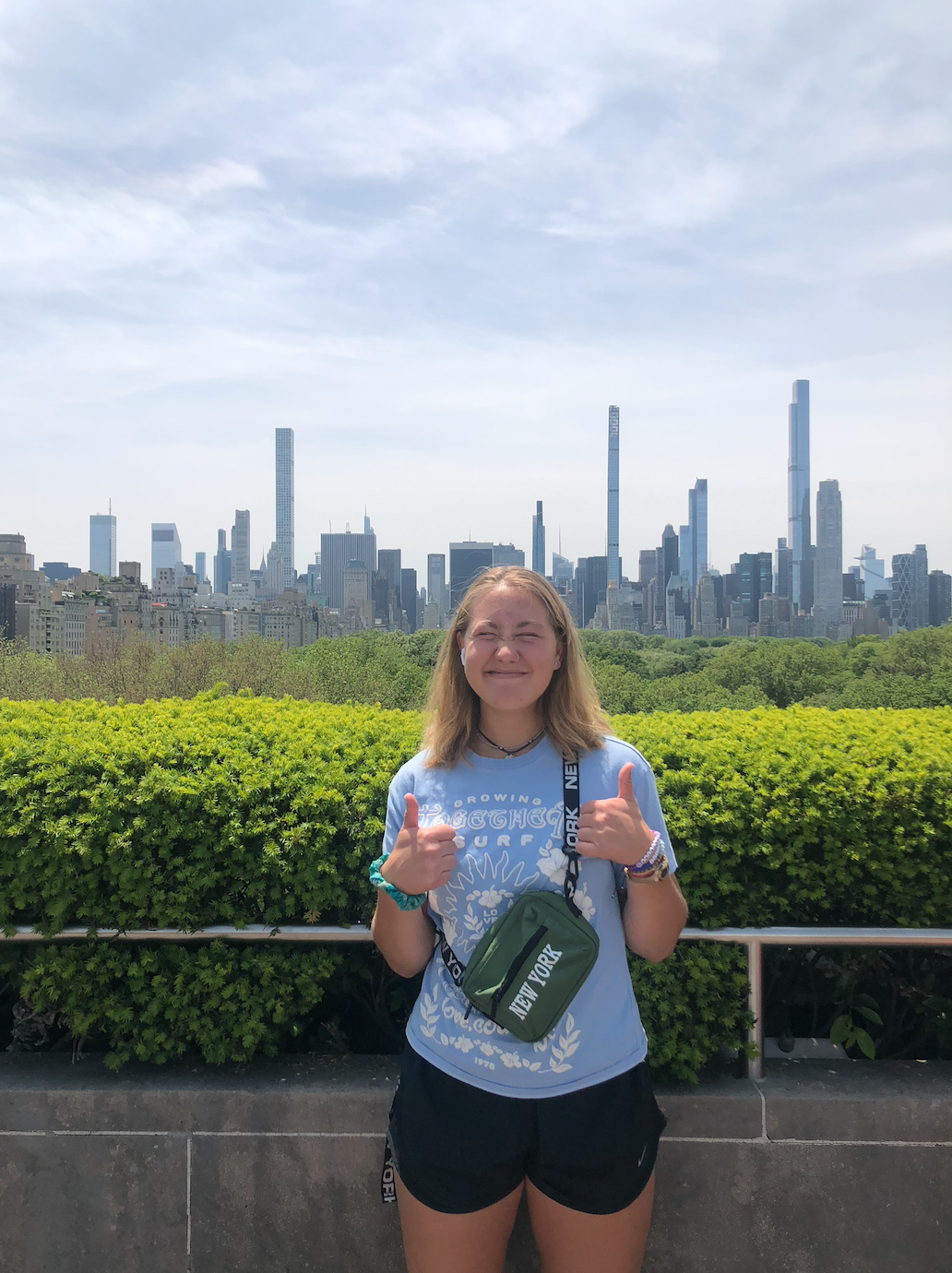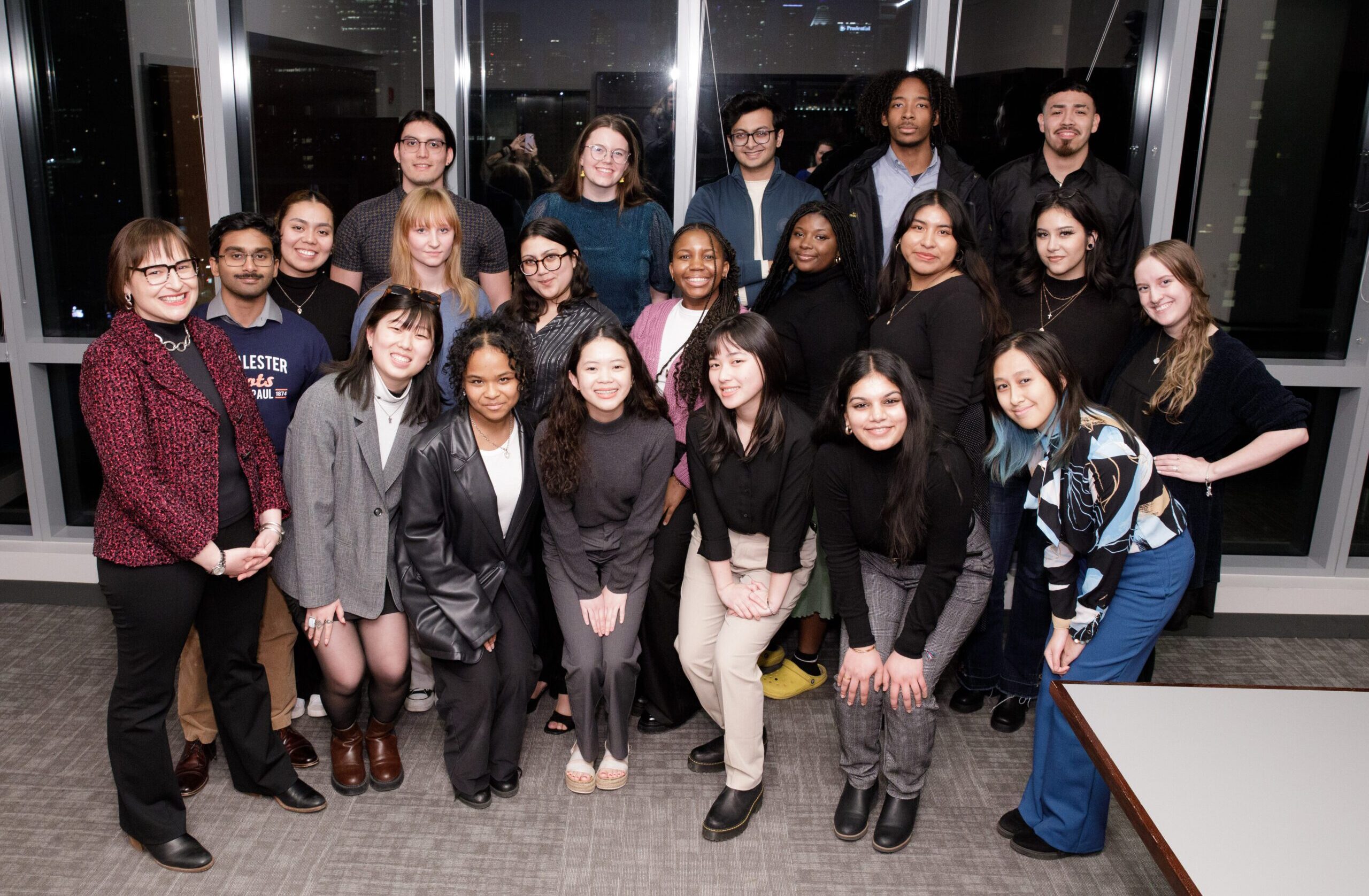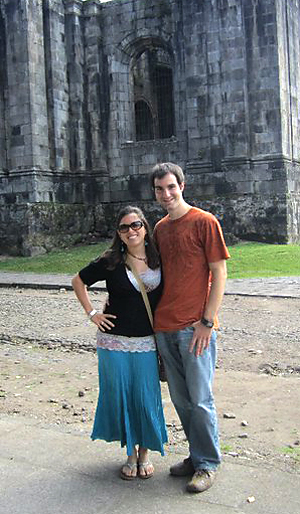 Stuart Pearlman and fellow student Mariah Mateo on a program field trip to Cartago.
Stuart Pearlman and fellow student Mariah Mateo on a program field trip to Cartago.
While studying on ACM’s Costa Rica program last fall, Stuart Pearlman got his picture in a national newspaper, talked about culture and politics with some famous Costa Ricans, and explored the country’s natural beauty, from mountains to beaches to rainforests.
As memorable as those experiences were, though, they pale in comparison to the time he spent living and working with a family on a remote farm in the northeastern corner of Costa Rica.
“It was one of the most enriching experiences of my life,” said Pearlman, who is a Spanish and economics major at Lake Forest College. “The family is what made it so remarkable. They welcomed me in. They treated me as an equal.”
The range of Pearlman’s experiences in Costa Rica grew out of the ACM program’s curriculum, with a very large assist – especially in the case of his fleeting bit of tabloid fame, but more on that later – from Pearlman’s curiosity and quick wit.
Participants in the Costa Rica: Language, Society, & the Environment program live with host families in the capital city of San José and take classes at the ACM center in Spanish language, Costa Rican culture and society, and environmental issues. They also engage in community activities and travel widely in field trips, typically visiting coffee and banana plantations, rainforests, coastal areas, volcanoes, and museums and historic sites.
Beauty in simplicity
For three weeks in the middle of the semester, the students scatter across the country for something completely different. On the rural stay, they get a taste of home and community life in a different type of environment outside the city.
So, suitcase in hand, Pearlman caught a bus in San José one morning and, after a long, tiring day of travel, met his host family in Las Colinas.
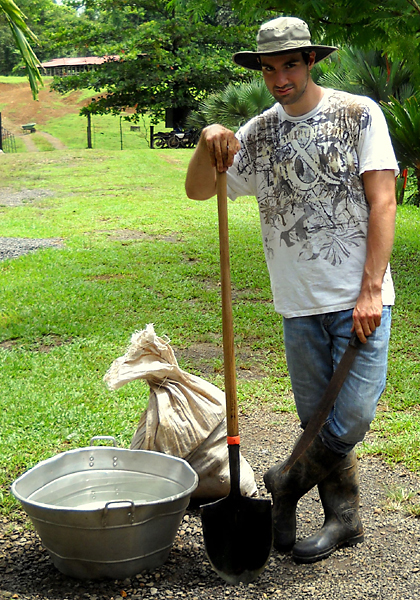 Stuart Pearlman on Don Carlos’ and Dona Nuria’s farm in Las Colinas.
Stuart Pearlman on Don Carlos’ and Dona Nuria’s farm in Las Colinas.
The initial adjustment to life on the farm with Don Carlos, Doña Nuria, and their sons was a bit rocky for Pearlman. The coastal heat and humidity, insects that could get through even the tightest mosquito netting, a diet heavy on tubers of various types – all of that made the first several days and nights feel interminable.
The isolation of the farm – off the power grid and situated a good distance from the nearest neighbors and town – loomed large, as well. “They did have phones, but you’d have to wait to get the half a bar of reception needed to send out a text message,” Pearlman recalled.
“Once the sun goes down, which it did the same time every day in Costa Rica, you have four or five hours until bed,” he continued. “Normally, for someone my age, that’s Facebook time, that’s video game time, see what’s on TV, instant message your friends. There were none of those options.”
“At first I just read a lot, but once the books were gone, that’s when my experience really started,” Pearlman said. “Then it was just me and Doña Nuria, the host mom, sitting and talking at a table about her views, what she thinks about the city, what she likes. Just to hear the way that she talked about living out there and working the land and the lives they led. The things that were just mundane for them were remarkable for me.”
See the video clip of Stuart Pearlman talking about his rural stay experience at the 2011 ACM Student Symposium on Off-Campus Study. |
Soon, Pearlman was pitching in alongside the family to help with the chores – planting, harvesting, milking the cows, making cheese, feeding the chickens and collecting eggs, cooking meals.
Part of every day included milking the cows, making a kind of quick cheese that is a staple of the Costa Rican diet, and transporting cheese by motorbike over rutted, dirt roads to the nearest refrigerator about seven miles away.
“Get up in the morning, corral the cows, and milk them,” Pearlman said, describing how a typical day on the farm would unfold. “They had probably 15 cows and calves. They just did it the old fashioned way. They’d get eight to ten gallons of milk. That goes into giant buckets. You add some enzymes, the curds and whey separate, and you give the whey to the pigs. You compress the curds with a little salt and you have cheese. That was fun.”
Pearlman’s four host brothers were all in their late teens or 20’s, and one was a student at the University of Costa Rica who came home on some of the weekends. “There were certain items the farm just didn’t produce and we had to go to town,” Pearlman noted. “It was a little bit of a drive, but once they got there, they’d have a list of chores two pages long – get the groceries, fix up the truck – and one of them always was, ‘Oh yeah, check our Facebooks on the internet.’ Definitely, they’re up to date. The same with the parents, they knew what was going on. They weren’t college educated like the children, but they were intellectual, they knew world events.”
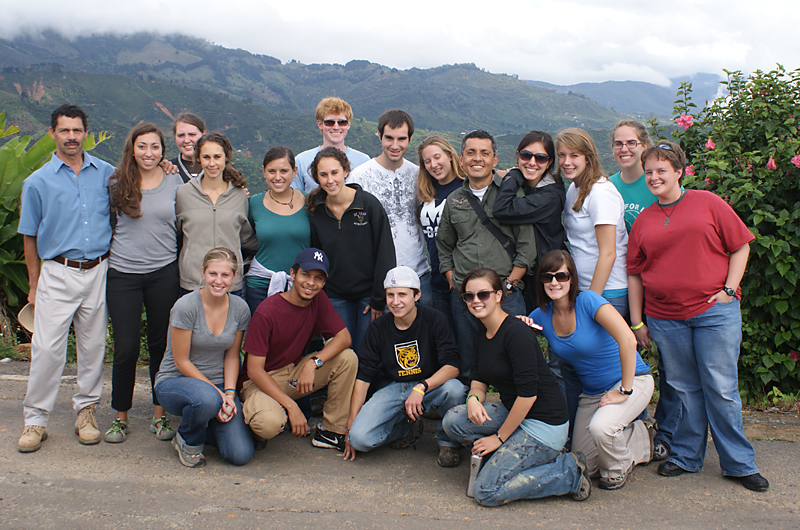 On a program field trip, students and staff take a coffee tour to Llano Bonito.
On a program field trip, students and staff take a coffee tour to Llano Bonito.
“A big part of the bonding experience with me and the family was carrying a giant 50 pound sack of potatoes next to Carlos carrying a 50 pound sack of potatoes. Doña Nuria’s there collecting eggs. We were all just kind of a cohesive unit,” said Pearlman. “It was about just keeping the farm going, sort of a collective consciousness and collective goals.”
When he returned to San José at the end of the three weeks, Pearlman found that it was difficult, and frustrating, to convey to others the depth of his experience on the farm.
“People would ask me how the trip went and I would tell them about it,” he said. “All they would hear is ‘No electricity, nothing that we would call running water.’ Their reaction was, ‘How is this a good thing?’ And I would try, and say ‘You don’t understand, there’s so much beauty in simplicity.'”
15 minutes, more or less, of fame
ACM’s long and deep connections in Costa Rica made it possible for Pearlman to go off the beaten path and live with Don Carlos and Doña Nuria and their family. Those connections, along with the nation’s small size and open, personal atmosphere, also offer students opportunities to interact with a range of prominent people. For example, Rodrigo Carazo, a former president of Costa Rica, visited the program to talk with students in November 2009.
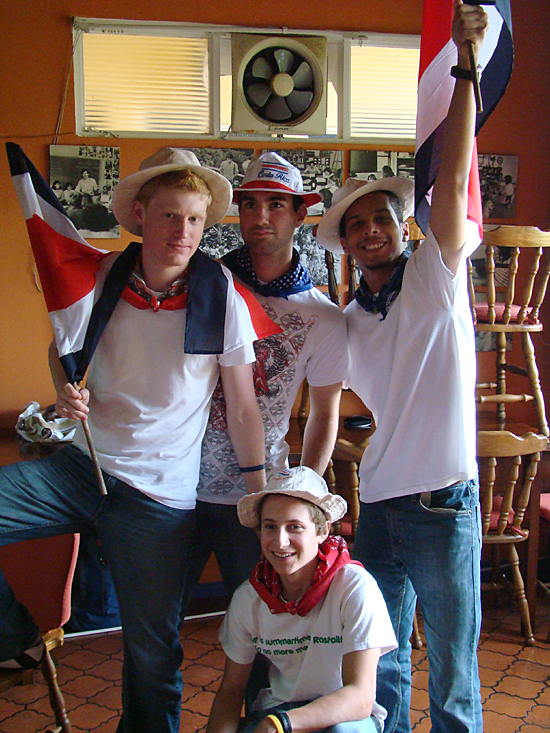 Celebrating Costa Rica Independence Day at the ACM Center.
Celebrating Costa Rica Independence Day at the ACM Center.
Pearlman particularly enjoyed the lively classroom discussions with well-known guests such as playwright, actress, and poet Ana Istarú, and novelist and environmental activist Ana Cristina Rossi. “Here is Ana Istarú in the newspaper today, and here she is in your classroom today,” he said. “I thought that was one of the nicer elements of the program.”
At the beginning of the semester, each student was assigned a daily newspaper to read and report on in Spanish class as a way to become familiar with current events in the country. That assignment planted the seeds of what might be called Pearlman’s “15 minutes of fame” in the Costa Rican press.
“Some people had The Republic, or The Nation, reputable news sources that covered major news events throughout the country,” Pearlman explained. “Other people covered news sources that were not as reputable, but still had social value.”
On a lark, Pearlman also started picking up a paper called La Teja, which he described as something akin to a Costa Rican version of the supermarket tabloids in the U.S. “It’s not a reputable news source, necessarily,” he said, “but I think that it helped with my cultural immersion.”
 Stuart Pearlman sporting his “La Teja” apparel with Spanish Language Coordinator Mario Morera (left) and Spanish instructor Mynor Segura.
Stuart Pearlman sporting his “La Teja” apparel with Spanish Language Coordinator Mario Morera (left) and Spanish instructor Mynor Segura.
His reports on La Teja’s contents – a steady stream of gossipy articles punctuated by pictures of women in bikinis – provided a daily source of amusement for other students and the program staff, especially Spanish Language Coordinator Mario Morera, who had given the newspaper assignment to the class. “It turned into an ongoing joke,” said Pearlman. “Any bus ride that was longer than 30 minutes required a copy of La Teja.”
One day, Pearlman decided to write a fan letter to the paper. “I didn’t think anything would come of it, I just thought it would be a fun thing to type up,” he said. “I wrote them an email that roughly translated to ‘Hey, what’s up, La Teja? It’s me, Stuart. I love your newspaper. I read it all the time. I think it’s great. I was wondering if maybe you could stop by and give me a free t-shirt. I’m a size medium, and you can find me at this address.’ I put the address of the ACM building.”
Fourteen hours later, a reporter and photographer from the newspaper were at the gate to the ACM center, La Teja t-shirt and hat in hand. A quick interview and photo shoot ensued, and soon after, Pearlman had his moment of tabloid fame.
“Slow news day, I guess,” he observed.
“Cultivating Mindfulness”
This past April, several months after he returned from Costa Rica, Pearlman was selected by his college to participate in the third annual ACM Student Symposium on Off-Campus Study. Pearlman chose to speak on the topic “Cultivating Mindfulness: A Reflection on My Time in Rural Costa Rica.”
 Stuart Pearlman presenting at the ACM Student Symposium on Off-Campus Study.
Stuart Pearlman presenting at the ACM Student Symposium on Off-Campus Study.
With great humor and warmth, he spun the tale of his hot, tiring journey from San José to Las Colinas, his first few days on the farm, and the growing realization that what he was experiencing was too rich for words to truly explain.
Concluding his presentation, Pearlman said:
“There are no words for the hard-earned love that I gained for the land after planting nearly three acres of camote shoulder-to-shoulder with two Nicaraguan workers. My tongue can touch my palate and remember tasting the stubbly flesh of the 25 pound jungle rat known as the tepezcuintle, but it cannot transform the meal into words. I can tell you about how the sun never really set so much as bled into darkness, but you will not visualize the clouds leaching the light from the sky, as I do.
“Adjectives cannot carry you to the crests and curves of the soft green hills where I spent my October. Yet as selfish as it is, I need no words to preserve my experience. Every time a warm breeze cuts through the stale air, my mind returns to that place of sweat and tranquility, whose beauty could not escape me and that language could not touch.”
Photos courtesy of Stuart Pearlman and the ACM Costa Rica Program.
Links:
- “Cultivating Mindfulness: A Reflection on My Time in Rural Costa Rica” – Stuart Pearlman’s presentation at the 2011 ACM Student Symposium on Off-Campus Study
- Costa Rica: Language, Society, and the Environment
- Read more about the program in the fall semester Costa Rica student blogs
- Costa Rica: Field Research in the Environment, Social Sciences, & Humanities
- Other articles about the ACM Costa Rica programs:
It Takes a Country to Teach a Language
From Sea Turtles to Calypso, Students Get Hands-On Research Experience in Costa Rica






